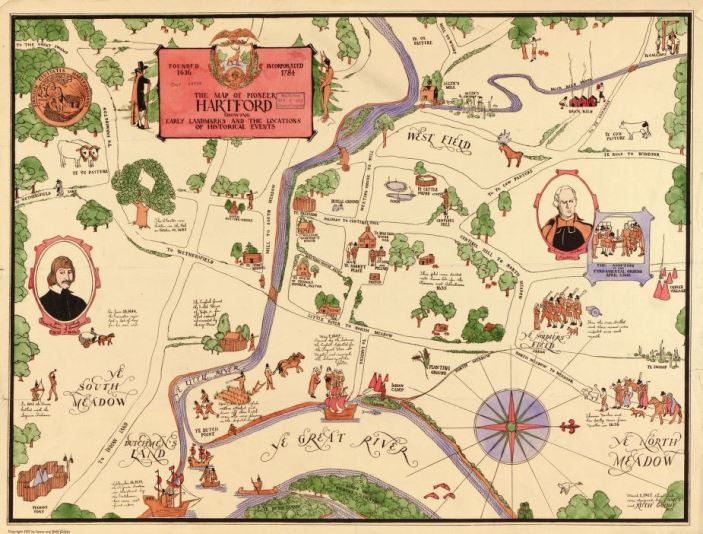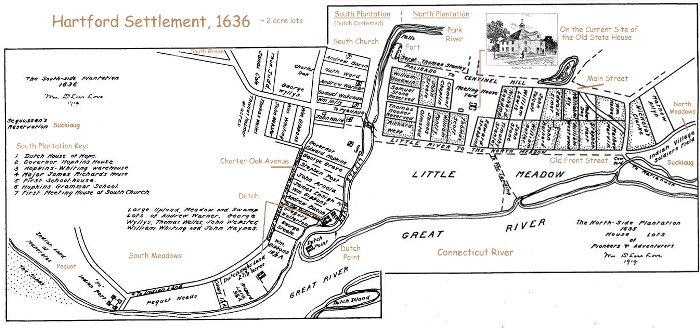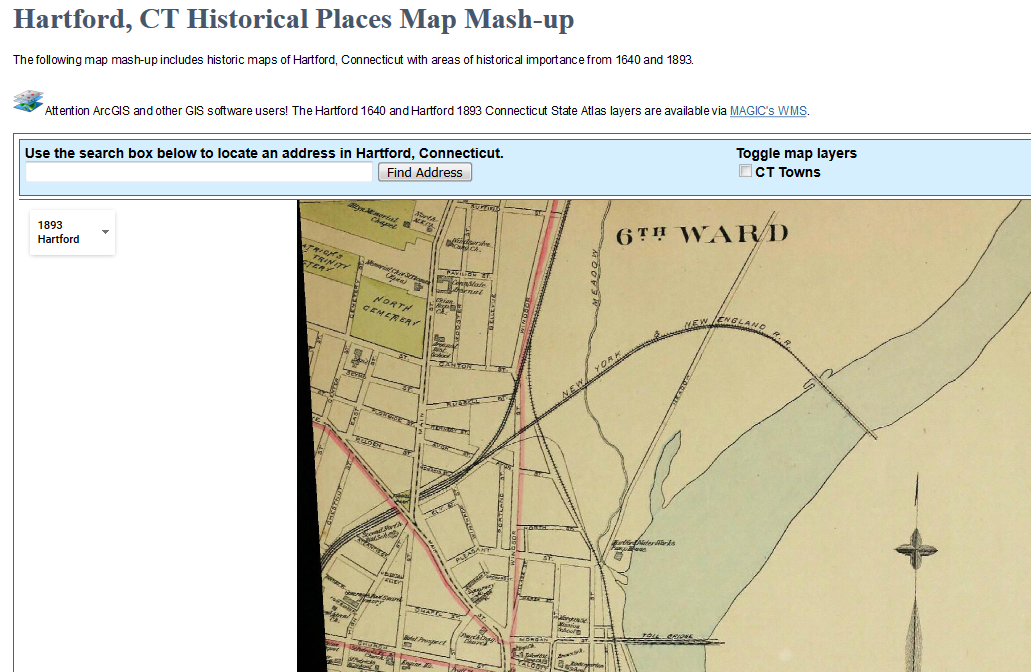by Laura Krenicki
William J. Johnston Middle School, Colchester
TEACHER'S SNAPSHOT
Subjects:
Colonial History, Environment, Exploration & Discovery, Geography
Course Topics/Big Ideas:
Influence of Geography on the Social, Political, and Economic Development of CT Towns and the State
Grade:
Grade 3
Lesson Plan Notes
This activity is built around different maps of Hartford:
The Map of Pioneer Hartford
Hartford, named after the English town of Hertford, was established in 1636. Though Rev. Thomas Hooker is credited with starting the English colony, there was already a Dutch settlement and Native American settlements in the same region. In fact, the state name Connecticut originates from the Mohegan word quonehtacut, meaning “place of long tidal river,” which runs alongside Hartford. This colonial map of Hartford shows how different cartographers (map makers) view space and place. Here, you’ll notice there are few streets, but there are landmarks and family names.
Hartford Settlement, 1636
There are several Native American references on the map. Can your students spot them all? Several groups of Native Peoples lived in the Hartford area, and they have a strong cultural heritage in our state (For more info: Pequot Museum). In fact, many Native Peoples died when Europeans settled in the area because of exposure to new diseases. Using the CDC.gov website, have students find areas of the world requiring immunizations for travelers. Why are immunizations important?
Mash-up Map
Over time, more maps were made of Hartford and more details were added as the community grew larger. In the upper left corner of the map is a drop-down menu. Choose one of the maps in the drop-down menu to compare to the map listed above. What questions do you have about the two maps? For more information, you may wish to check out this website: Map of the Week! #3 Hartford in 1640 and 1893.
ESSENTIAL QUESTION
SUPPORTING QUESTIONS
- How were local landmarks and neighborhoods named?
- Why were specific individuals in your community honored through monuments or memorials, and how did they affect the history of your town, state, and country?
- What historical events occurred in your town/city?
ACTIVITY
Have students notice how the map is oriented.
- Which way is north?
- How can they tell?
- Which way does the Connecticut River flow?
The founding of Hartford was dependent on the Connecticut River.
- Why was the river so important then?
- How is it important to Hartford now?
For further consideration:
- How important is scale on a map?
- If they were to use this Pioneer Map of Hartford, how close would things seem?
- How might this be misleading if students were going to walk from Soldier’s Field to West Field?
- How did these places get their names?
OPPORTUNITIES FOR ASSESSMENT
Have students create a personal map from their house to your school. Have students ask their families to see how their community has changed over time.
As a class discussion, consider these questions:
- What things would you think are important to include in your map?
- What details or landmarks would you include in your map and what would you leave off?
RESOURCE TOOL KIT
Things you will need to teach this lesson:

“The Map of Pioneer Hartford: Founded 1636, Incorporated 1784, Showing Early Landmarks and the Locations of Historical Events”, ca. 1927 by James and Ruth Goldie – Library of Congress, Geography and Map Division.

“Hartford Settlement, 1636” map created from two separate maps, originally published in The Colonial History of Hartford by Rev. William DeLoss Love, 1811, on the website Kenyon Street: Hartford’s West End.
ADDITIONAL RESOURCES
Places to GO
FoundersofHartford.org – Consider the compelling question and the three additional questions above. How would the Colonial Map help you to answer those questions? The Founders of Hartford website helps to identify some of the monuments in Hartford using a modern map, and provides the historical background for those honored.
Things To DO
Maps like this can tell a lot about how things were in the past. If you were working for the State Archaeologist, how could maps like this help in learning about Connecticut history? Using the map, where might you search for artifacts with clues to our past? To learn more, check out the Office of State Archaeology located at UConn.
For further research, and ways to help protect the Connecticut River from pollution, you may be interested in ConnecticutRiver.us.
Websites to VISIT
For more maps to explore take a look at the University of Connecticut’s – Historical Map Collection: Connecticut.
Articles to READ
The importance of the Connecticut River to early settlements in Connecticut may be found at the Connecticut History website. ConnecticutHistory.org topic: The Connecticut River




